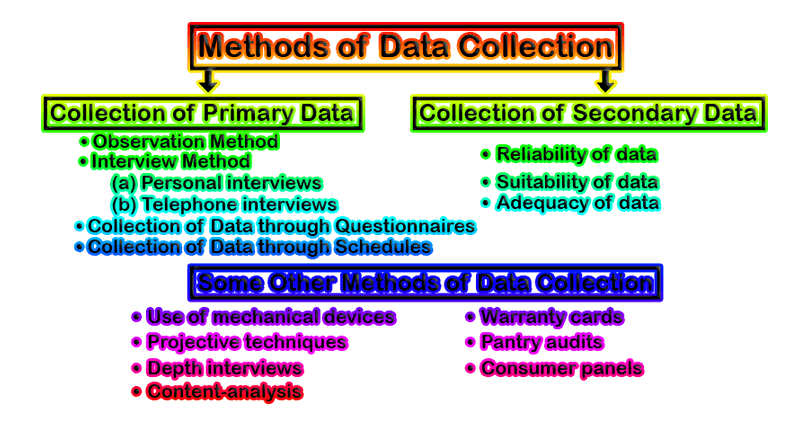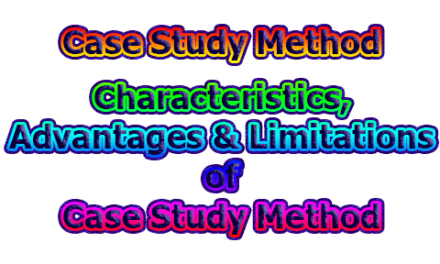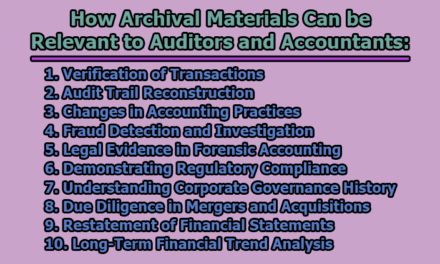Methods of Data Collection
The method of data collection to be used for the study, the researcher should keep in mind two types of data viz., primary and secondary. The primary data are those which are collected afresh and for the first time, and thus happen to be original in character. The secondary data, on the other hand, are those which have already been collected by someone else and which have already been passed through the statistical process. The researcher would have to decide which sort of data he would be using (thus collecting) for his study and accordingly he will have to select one or the other method of data collection. The methods of collecting primary and secondary data differ since primary data are to be originally collected, while in the case of secondary data the nature of data collection work is merely that of compilation. We describe the different methods of data collection, with the pros and cons of each method.
Collection of Primary Data:
We collect primary data during the course of doing experiments in experimental research but in case we do research of the descriptive type and perform surveys, whether sample surveys or census surveys, then we can obtain primary data either through observation or through direct communication with respondents in one form or another or through personal interviews. There are several methods of collecting primary data, particularly in surveys and descriptive researches which are briefly described below;
- Observation Method: The observation method is the most commonly used method especially in studies relating to behavioral sciences. In a way, we all observe things around us, but this sort of observation is not scientific observation. Observation becomes a scientific tool and the method of data collection for the researcher, when it serves a formulated research purpose, is systematically planned and recorded and is subjected to checks and controls on validity and reliability. Under the observation method, the information is sought by way of the investigator’s own direct observation without asking from the respondent. For instance, in a study relating to consumer behavior, the investigator instead of asking the brand of wristwatch used by the respondent, may himself look at the watch.
The main advantage of this method is that subjective bias is eliminated if the observation is done accurately. Secondly, the information obtained under this method relates to what is currently happening; it is not complicated by either the past behavior or future intentions or attitudes. Thirdly, this method is independent of respondents’ willingness to respond and as such is relatively less demanding of active cooperation on the part of respondents as happens to be the case in the interview or the questionnaire method. This method is particularly suitable in studies that deal with subjects (i.e., respondents) who are not capable of giving verbal reports of their feelings for one reason or the other. However, the observation method has various limitations. Firstly, it is an expensive method. Secondly, the information provided by this method is very limited. Thirdly, sometimes unforeseen factors may interfere with the observational task. At times, the fact that some people are rarely accessible to direct observation creates obstacles for this method to collect data effectively.
While using this method, the researcher should keep in mind things like What should be observed? How the observations should be recorded? Or how the accuracy of observation can be ensured?
- Interview Method: The interview method of collecting data involves the presentation of oral-verbal stimuli and reply in terms of oral-verbal responses. This method can be used through personal interviews and, if possible through telephone interviews.
(a) Personal interviews: Despite the variations in interview techniques, the major advantages and weaknesses of personal interviews can be enumerated in a general way. The chief merits of the interview method are as follows:
- More information and that too in greater depth can be obtained.
- Interviewer by his own skill can overcome the resistance, if any, of the respondents; the interview method can be made to yield an almost perfect sample of the general population.
- There is greater flexibility under this method as the opportunity to restructure questions is always there, especially in the case of unstructured interviews.
- The observation method can as well be applied to recording verbal answers to various questions.
- Personal information can as well be obtained easily under this method.
- Samples can be controlled more effectively as there arises no difficulty of the missing returns; non-response generally remains very low.
- The interviewer can usually control which person(s) will answer the questions. This is not possible in the mailed questionnaire approach. If so desired, group discussions may also be held.
- The interviewer may catch the informant off-guard and thus may secure the most spontaneous reactions than would be the case if a mailed questionnaire is used.
- The language of the interview can be adapted to the ability or educational level of the person interviewed and as such misinterpretations concerning questions can be avoided.
- The interviewer can collect supplementary information about the respondent’s personal characteristics and environment which is often of great value in interpreting results.
But there are also certain weaknesses of the interview method. Among the important weaknesses, mention may be made of the following:
- It is a very expensive method, especially when a large and widely spread geographical sample is taken.
- There remains the possibility of the bias of the interviewer as well as that of the respondent; there also remains the headache of supervision and control of interviewers.
- Certain types of respondents such as important officials or executives or people in high-income groups may not be easily approachable under this method and to that extent, the data may prove inadequate.
- This method is relatively more time-consuming, especially when the sample is large and re[1]calls upon the respondents are necessary.
- The presence of the interviewer on the spot may over-stimulate the respondent, sometimes even to the extent that he may give imaginary information just to make the interview interesting.
- Under the interview method, the organization required for selecting, training, and supervising the field staff is more complex with formidable problems.
- Interviewing at times may also introduce systematic errors.
- Effective interview presupposes proper rapport with respondents that would facilitate free and frank responses. This is often a very difficult requirement.
(b) Telephone interviews: This method of collecting information consists in contacting respondents on the telephone itself. It is not a very widely used method, but plays an important part in industrial surveys, particularly in developed regions. The chief merits of such a system are:
- It is more flexible in comparison to the mailing method.
- It is faster than other methods i.e., a quick way of obtaining information.
- It is cheaper than the personal interviewing method; here the cost per response is relatively low. 4. Recall is easy; callbacks are simple and economical.
- There is a higher rate of response than what we have in the mailing method; the non-response is generally very low.
- Replies can be recorded without causing embarrassment to respondents.
- Interviewers can explain requirements more easily.
- At times, access can be gained to respondents who otherwise cannot be contacted for one reason or the other.
- No field staff is required.
- Representative and wider distribution of the sample is possible.
But this system of collecting information is not free from demerits. Some of these may be highlighted.
- Little time is given to respondents for considered answers; the interview period is not likely to exceed five minutes in most cases.
- Surveys are restricted to respondents who have telephone facilities.
- Extensive geographical coverage may get restricted by cost considerations.
- It is not suitable for intensive surveys where comprehensive answers are required to various questions.
- The possibility of the bias of the interviewer is relatively more.
- Questions have to be short and to the point; probes are difficult to handle.
- Collection of Data through Questionnaires: This method of data collection is quite popular, particularly in the case of big inquiries. It is being adopted by private individuals, research workers, private and public organizations, and even by governments. In this method, a questionnaire is sent (usually by post) to the persons concerned with a request to answer the questions and return the questionnaire. A questionnaire consists of a number of questions printed or typed in a definite order on a form or set of forms. The questionnaire is mailed to respondents who are expected to read and understand the questions and write down the reply in the space meant for the purpose of the questionnaire itself. The respondents have to answer the questions on their own.
The method of collecting data by mailing the questionnaires to respondents is most extensively employed in various economic and business surveys. The merits claimed on behalf of this method are as follows:
- There is low cost even when the universe is large and is widely spread geographically.
- It is free from the bias of the interviewer; answers are in respondents’ own words.
- Respondents have adequate time to give well-thought-out answers.
- Respondents, who are not easily approachable, can also be reached conveniently.
- Large samples can be made use of and thus the results can be made more dependable and reliable.
The main demerits of this system can also be listed here:
- Low rate of return of the duly filled in questionnaires; bias due to no-response is often indeterminate.
- It can be used only when respondents are educated and cooperating.
- The control over the questionnaire may be lost once it is sent.
- There is inbuilt inflexibility because of the difficulty of amending the approach once questionnaires have been dispatched.
- There is also the possibility of ambiguous replies or omission of replies altogether to certain questions; interpretation of omissions is difficult.
- It is difficult to know whether willing respondents are truly representative.
- This method is likely to be the slowest of all.
- Collection of Data through Schedules: This method of data collection is very much like the collection of data through questionnaires, with little difference which lies in the fact that schedules are being filled in by the enumerators who are specially appointed for the purpose. In certain situations, schedules may be handed over to respondents and enumerators may help them in recording their answers to various questions in the said schedules. Enumerators explain the aims and objects of the investigation and also remove the difficulties which any respondent may feel in understanding the implications of a particular question or the definition or concept of difficult terms.
Some Other Methods of Data Collection
Let us consider some other methods of data collection, particularly used by big business houses in modern times.
- Warranty cards: Warranty cards are usually postal-sized cards that are used by dealers of consumer durables to collect information regarding their products. The information sought is printed in the form of questions on the ‘warranty cards’ which are placed inside the package along with the product with a request to the consumer to fill in the card and post it back to the dealer.
- Distributor or store audits: Distributor or store audits are performed by distributors as well as manufacturers through their salesmen at regular intervals. Distributors get the retail stores audited through salesmen and use such information to estimate market size, market share, and seasonal purchasing patterns, and so on. The data are obtained in such audits not by questioning but by observation.
- Pantry audits: The pantry audit technique is used to estimate the consumption of the basket of goods at the consumer level. In this type of audit, the investigator collects an inventory of types, quantities, and prices of commodities consumed. Thus in pantry audit data are recorded from the examination of the consumer’s pantry. The usual objective in a pantry audit is to find out what types of consumers buy certain products and certain brands, the assumption being that the contents of the pantry accurately portray consumer’s preferences. Quite often, pantry audits are supplemented by direct questioning relating to reasons and circumstances under which particular products were purchased in an attempt to relate these factors to purchasing habits.
- Consumer panels: A consumer panel is essentially a sample of consumers who are interviewed repeatedly over a period of time. A continuing consumer panel is often set up for an indefinite period with a view to collect data on a particular aspect of consumer behavior over time, generally at periodic intervals or maybe meant to serve as a general-purpose panel for researchers on a variety of subjects.
- Use of mechanical devices: The use of mechanical devices has been widely made to collect information by way of indirect means. Eye camera, Pupilometric camera, Psych-galvanometer, Motion picture camera, and Audiometer are the principal devices so far developed and commonly used by modern big business houses, mostly in the developed world for the purpose of collecting the required information.
- Projective techniques: for the collection of data have been developed by psychologists to use projections of respondents for inferring about underlying motives, urges, or intentions which are such that the respondent either resists to reveal them or is unable to figure out himself. In projective techniques, the respondent in supplying information tends unconsciously to project his own attitudes or feelings on the subject under study. Projective techniques play a significant role in motivational researches or in attitude surveys. The use of these techniques requires intensive specialized training.
- Depth interviews: Depth interviews are those interviews that are designed to discover underlying motives and desires and are often used in motivational research. Such interviews are held to explore the needs, desires, and feelings of respondents. In other words, they aim to elicit unconscious as also other types of material relating especially to personality dynamics and motivations. As such, depth interviews require great skill on the part of the interviewer and at the same time involve considerable time. Unless the researcher has the specialized training, depth interviewing should not be attempted.
- Content-analysis: Content-analysis consists of analyzing the contents of documentary materials such as books, magazines, newspapers, and the contents of all other verbal materials which can be either spoken or printed.
A review of research in any area, for instance, involves the analysis of the contents of research articles that have been published. The analysis may be at a relatively simple level or maybe a subtle one. It is at a simple level when we pursue it on the basis of certain characteristics of the document or verbal materials that can be identified and counted.
Collection of Secondary Data:
Secondary data means data that are already available i.e., they refer to the data which have already been collected and analyzed by someone else. When the researcher utilizes secondary data, then he has to look into various sources from where he can obtain them. In this case, he is certainly not confronted with the problems that are usually associated with the collection of original data. Secondary data may either be published data or unpublished data. Usually published data are available in (a) various publications of the central, state are local governments; (b) various publications of foreign governments or of international bodies and their subsidiary organizations; (c) technical and trade journals; (d) books, magazines and newspapers; (e) reports and publications of various associations connected with business and industry, banks, stock exchanges, etc.; (f) reports prepared by research scholars, universities, economists, etc. in different fields; and (g) public records and statistics, historical documents, and other sources of published information. The sources of unpublished data are many; they may be found in diaries, letters, unpublished biographies, and autobiographies and also may be available with scholars and research workers, trade associations, labor bureaus, and other public/ private individuals and organizations.
A researcher must be very careful in using secondary data because it is just possible that the secondary data may be unsuitable or may be inadequate in the context of the problem which the researcher wants to study. By way of caution, the researcher, before using secondary data, must see that they possess the following characteristics:
- Reliability of data: The reliability can be tested by finding out such things about the said data:
(a) Who collected the data?
(b) What were the sources of data?
(c) Were they collected by using proper methods?
(d) At what time were they collected?
(e) Was there any bias of the compiler?
(t) What level of accuracy was desired? Was it achieved?
- Suitability of data: The data that is suitable for one inquiry may not necessarily be found suitable in another inquiry. Hence, if the available data are found to be unsuitable, they should not be used by the researcher. In this context, the researcher must very carefully scrutinize the definition of various terms and units of collection used at the time of collecting the data from the primary source originally. Similarly, the object, scope, and nature of the original inquiry must also be studied. If the researcher finds differences in these, the data will remain unsuitable for the present inquiry and should not be used.
- Adequacy of data: If the level of accuracy achieved in data is found inadequate for the purpose of the present inquiry, they will be considered inadequate and should not be used by the researcher. The data will also be considered inadequate if they are related to an area that may be either narrower or wider than the area of the present inquiry.
Selection of Appropriate Method for Data Collection
Thus, there are various methods of data collection. As such the researcher must judiciously select the method/methods for his own study, keeping in view the following factors:
- Nature, scope, and object of inquiry: This constitutes the most important factor affecting the choice of a particular method. The method selected should be such that it suits the type of inquiry that is to be conducted by the researcher. This factor is also important in deciding whether the data already available (secondary data) are to be used or the data not yet available (primary data) are to be collected.
- Availability of funds: The availability of funds for the research project determines to a large extent the method to be used for the collection of data. When funds at the disposal of the researcher are very limited, he will have to select a comparatively cheaper method that may not be as efficient and effective as some other costly method. Finance, in fact, is a big constraint in practice and the researcher has to act within this limitation.
- Time factor: Availability of time has also to be taken into account in deciding a particular method of data collection. Some methods take relatively more time, whereas with others the data can be collected in a comparatively shorter duration. The time at the disposal of the researcher, thus, affects the selection of the method by which the data are to be collected.
- Precision required: Precision required is yet another important factor to be considered at the time of selecting the method of collection of data.
Finally, we can say that the most desirable approach with regard to the selection of the method depends on the nature of the particular problem and on the time and resources (money and personnel) available along with the desired degree of accuracy. But, over and above all this, much depends upon the ability and experience of the researcher.
Reference: Research Methodology written by C.R. Kothari

Assistant Teacher at Zinzira Pir Mohammad Pilot School and College










